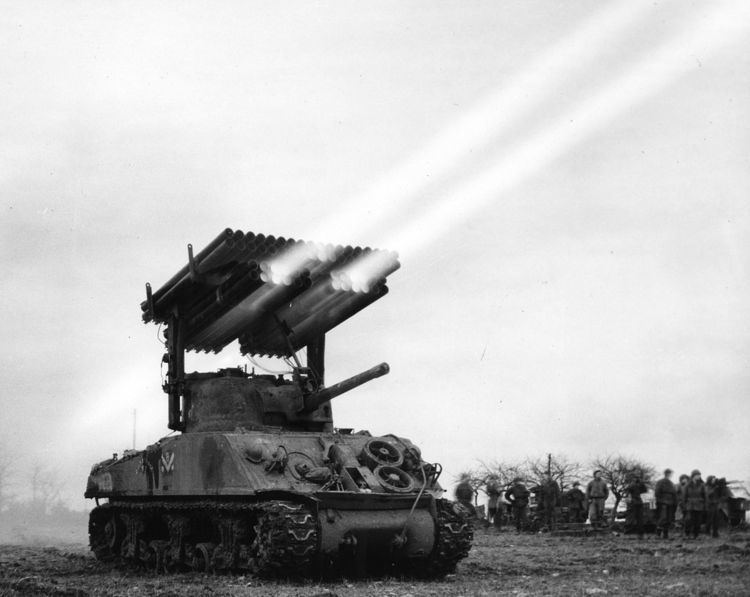Place of origin United States Designed 1941 | ||
 | ||
Manufacturer Chrysler Corporation, Highland Park Plant (328,327); Hercules Powder Company Radford Ordnance Works and Sunflower Ordnance Works (solvent powder) | ||
The M8 was a 4.5-inch (110 mm) rocket developed and used by the United States military during World War II. Produced in the millions, it was fired from both air- and ground-based launchers; it was replaced by the M16 rocket in 1945.
Contents
Development
The first modern research into military solid-propellant rockets in the United States was conducted by Colonel Leslie Skinner at the Aberdeen Proving Ground in 1932. Little interest was shown by the US Armed Forces however, until the introduction of a British anti-aircraft rocket; both nations exchanged their research data before the United States entered World War II. The M8 rocket was developed by the National Defense Research Committee and the Army Ordnance Department in the early 1940s; at Picatinny Arsenal. The specifications were agreed in the summer of 1941 after examining equivalent British rockets. Skinner produced the first prototypes which were tested at Aberdeen that fall, improvised from old fire extinguisher tanks for rocket casings, thereby determining the 4.5 inch diameter. It was fin stabilized, a system that proved less than satisfactory for low velocity, ground launched rockets.
Original priority was given to an air-to-ground version, confidence in the initial results was so high that the USAAF had ordered 3,500 rockets before any had been actually fitted to an aircraft and it was hoped to have them operational in time for Operation Torch, the invasion of North Africa, in October 1942. The successful launch of an M8 from a Curtiss P-40E fighter on July 6, 1942 resulted in a procurement order for 600,000 units. Development began on a reloadable launcher that could be fitted in the bomb bay of an Douglas A-20 bomber, but this never became operational. There were considerable problems with the propellant, the fuzes and the underwing launching tubes, all of which considerably delayed operational deployment.
The initial production model was given the Army designation of M8; improvements resulted in the M8A3, with a more powerful rocket engine and enlarged fins, and the T22, which had improved reliability and modifications to make the rocket safer.
Operational history
Entering service in 1943, the M8 family of rockets saw service with the United States Army, which classified the M8 as a "barrage rocket". The rocket was also widely used by the United States Army Air Forces. Over 2,500,000 of the M8 type rocket had been produced by the end of the war.
Ground role
Operational service showed some drawbacks in the M8's performance; ground launch resulted in the rockets' fin stabilizers proving ineffective, reducing the accuracy of the rocket; despite this, it was considered an effective barrage weapon. Due to the lack of accuracy, when ground-launched, it was being launched from large multiple launchers; the most commonly used being eight- and 60-tube launchers, called "xylophones" and "calliopes" respectively. The "calliope", given the official designation T34, was mounted on top of a M4 Sherman tank; once fired, the launcher could be detached and discarded, allowing the tank to be used in conventional combat, while the "xylophone", officially the T27, was carried on a 2½-ton truck's cargo bed. A 120-round launcher, designated T44, and a 144-round T45 launcher were also developed; these were intended for use by the United States Navy, being mounted on DUKW amphibious vehicles and LST amphibious warfare vessels. Single- and twin-14-round launchers were also developed.
The M8 showed poor effectiveness against hardened targets; this resulted in the development of the Super M8, which had larger fins, a more powerful rocket and a more powerful warhead. The Super M8 underwent testing in late 1944, but failed to see combat. The M8 was replaced by the improved spin-stabilized M16 rocket during 1945.
Aircraft role
The method of launching the M8 from the wings of fighters were finally solved by the development of a triple tube launcher made of plastic or alloy. However, the modification required to adapt existing aircraft to carry these launchers was vastly more complicated than that required for the 5-inch High Velocity Aircraft Rocket (HVAR) or "Holy Moses" which had been developed by the US Navy and was better in some respects than the M8 in performance. The M8 was initially available in greater numbers than the HVAR, and was fitted to the Republic P-47 of the Ninth Air Force in Italy and Northwest Europe during the second half of 1944, before being gradually replaced by the HVAR. However, the air-launched rocket was never a popular weapon with US fighter-bomber squadrons.
